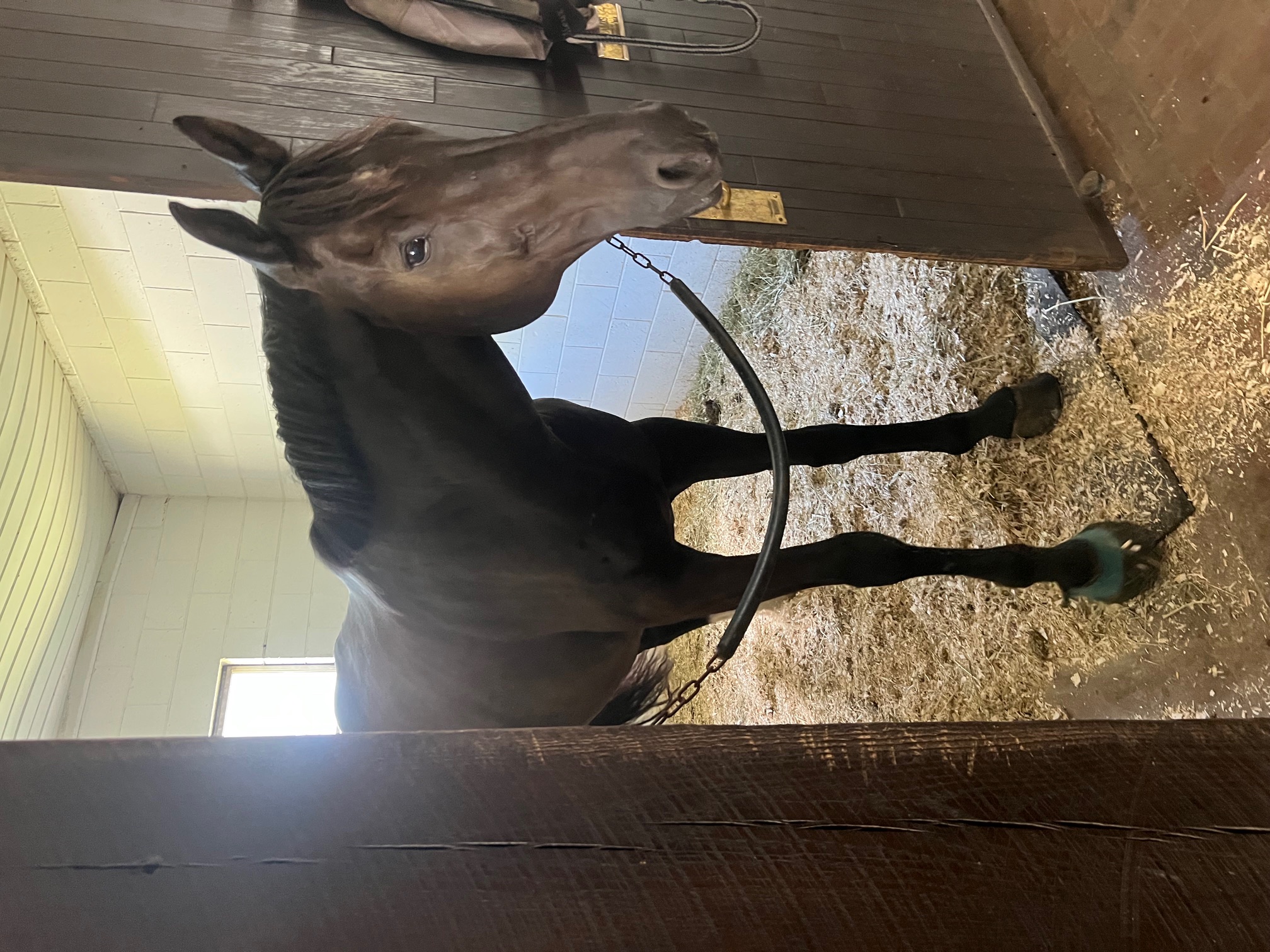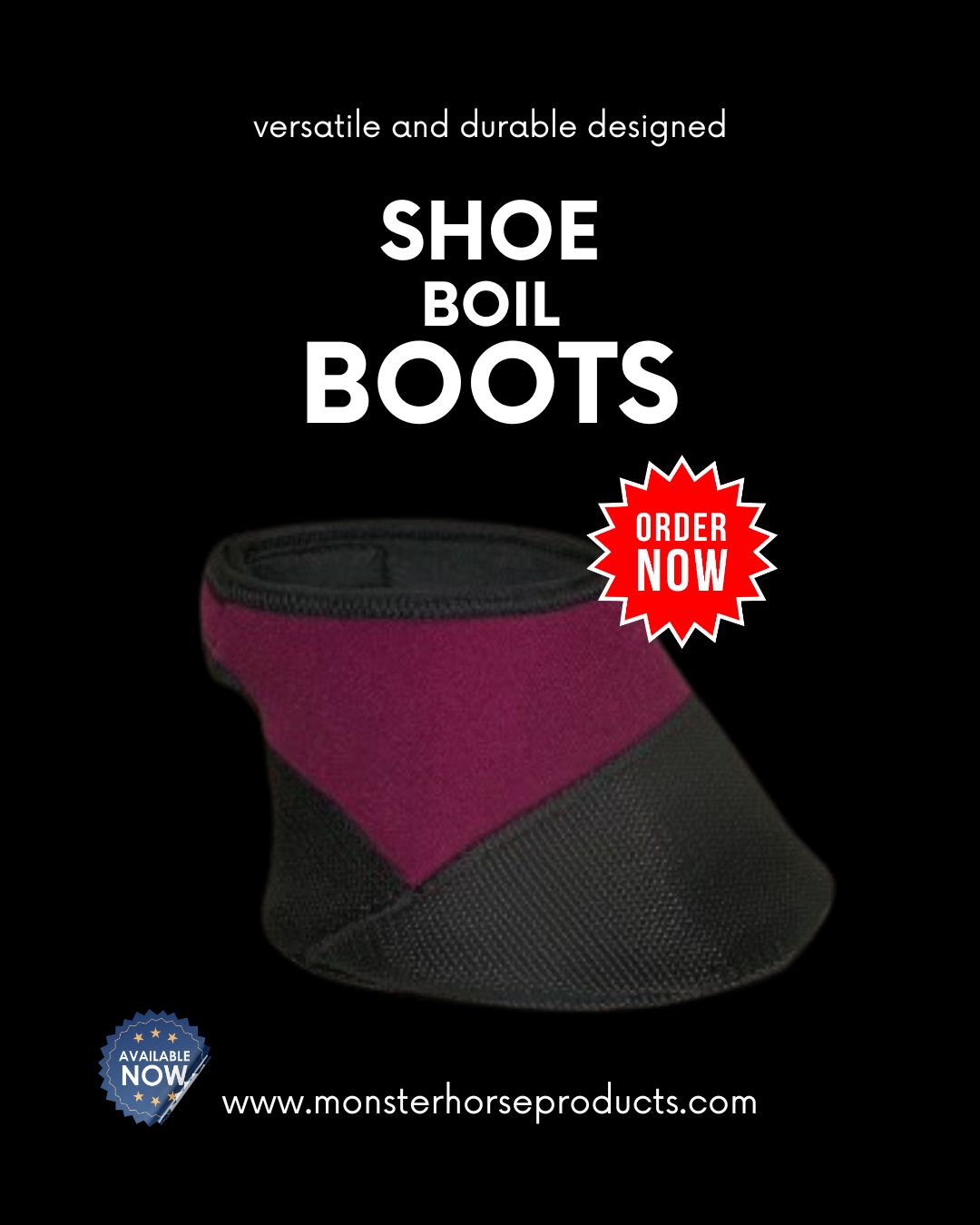Healthy Hooves & Beyond
Monster Featured Friends

Aramis says thank you for the boot.
It fits like a glove, he loves wearing it and the shoe boil is looking under control.
We appreciate all your help Kim.
- Lidiya and Aramis
Tewksbury NJ
Prevent Shoe Boils, Olecranon Bursitis or Capped Elbow in Horses | Shoe Boil Don't Bother Me!
Shoe boils, also known as olecranon bursitis or capped elbow, are a common condition in horses where swelling occurs at the point of the elbow. They are typically caused by repeated trauma, often when a horse lies down on hard surfaces. Treatment options include rest, cold therapy, fluid drainage, corticosteroid injections, or surgery. Prevention is key through protective boots and proper bedding.
What Are Shoe Boils in Horses?
- Shoe boils are soft, fluid-filled swellings over the horse's elbow due to inflammation of the bursa.
Causes of Shoe Boils
- Shoe boils are primarily caused by repeated trauma to the elbow area when lying down, often from horseshoes or hard surfaces.
Early Signs and Symptoms
- Look for swelling at the point of the elbow, heat, and mild lameness.
How Shoe Boils Are Diagnosed
- Veterinarians typically diagnose shoe boils based on a physical examination and history of trauma.
Treatment Options for Shoe Boils
- Common treatments include rest, cold therapy, drainage, corticosteroid injections, or surgical removal if chronic.
Shoe Boil Boots and Rings
- Protective padded devices like shoe boil boots help cushion the elbow and prevent further trauma.
Benefits of Using Shoe Boil Boots
- These boots minimize direct pressure, reduce swelling, and speed up recovery.
Importance of Proper Bedding
- Deep, cushioned bedding helps absorb shock and prevent elbow injuries when the horse lies down.
Fluid Drainage and Corticosteroid Injections
- In cases with large fluid buildup, vets may drain the bursa and inject corticosteroids to reduce inflammation.
When Surgery Is Needed
- Surgical intervention is necessary if the shoe boil becomes chronic, infected, or if fibrosis develops.
Preventing Shoe Boils
- Prevention includes using shoe boil boots, providing soft bedding, and ensuring horseshoes are properly fitted.
Risk Factors for Shoe Boils
- Heavy horses, poor bedding, and ill-fitting horseshoes increase the risk of developing shoe boils.
Recovery Time for Horses with Shoe Boils
- Mild cases resolve within a few weeks, but severe cases may take several months with proper care.
Long-Term Outlook
- With early treatment and good management, most horses recover fully without long-term issues.
Products That Help with Shoe Boils
Top products include:
When to Call the Veterinarian
Call your vet if swelling persists, worsens, or if signs of infection like fever or severe lameness appear.
Understanding and Treating Olecranon Bursitis (Capped Elbow) in Horses
A shoe boil, also known as olecranon bursitis or capped elbow, is more than just a cosmetic blemish — it’s a condition that can become painful, inflamed, or even infected if not addressed properly. Fortunately, with the right treatment, your horse can stay comfortable and healthy.
Let’s break down this common equine issue — what causes it, how to treat it, and most importantly, how to prevent it from bothering your horse in the first place.
What Is a Shoe Boil?
A shoe boil is a soft, fluid-filled swelling that appears on the horse’s elbow. It’s caused by trauma or repeated pressure to the bursa, a small sac filled with lubricating fluid that reduces friction around the elbow joint.
The name comes from the condition's typical cause — the horse's heel or horseshoe striking the elbow while lying down, especially on hard or poorly cushioned surfaces.
🚩 Signs and Symptoms
-
Visible swelling on the point of the elbow
-
Fluid-filled sac or lump
-
Warmth and mild sensitivity (in some cases)
-
Possible infection or discharge (if advanced)
While many shoe boils are painless and considered just a cosmetic issue, larger or infected boils can lead to discomfort, limited movement, or secondary infections.
⚠️ Causes of Shoe Boils
Shoe boils most often occur due to:
-
Lying on hard stall surfaces or uneven ground
-
Improper shoe fit that causes heel-to-elbow contact
-
Lack of adequate bedding in stalls or trailers
-
Thin-skinned or sensitive horses that are prone to elbow trauma

Treatment Options for Shoe Boils in Horses
1. Protect the Elbow from Further Trauma
Preventing more damage is the first step.
-
Shoe Boil Boots:
These specially designed boots wrap around the horse’s pastern and help keep the hoof from striking the elbow when the horse lies down. Our top recommendation is the Monster Shoe Boil Boot for daily use and turnout. -
Padding the Elbow:
Applying soft cotton padding or wraps can cushion the area and prevent direct impact during rest or transport.
2. Reduce Inflammation and Swelling
-
Anti-inflammatory Medications:
Your vet might recommend phenylbutazone (Bute) or flunixin meglumine (Banamine)</
“Take care of your horse and your horse will take care of you.” That old saying rings truer than ever when it comes to proper horse care — and nothing demonstrates responsible horsemanship more than understanding the 20% rule.
So, what does it mean? In simple terms: A horse should carry no more than 20% of its body weight, including the rider, saddle, and tack. But let’s break it down further, because following this rule can make the difference between a sound, happy horse and one at risk for injury or burnout.
🧠 What Exactly Is the 20% Rule?
The 20% rule is a widely recognized guideline in the equine world. It states that a horse can safely carry up to 20% of its body weight. That includes:
-
Rider
-
Saddle
-
Bridle
-
Any additional equipment
For example, a horse weighing 1,000 pounds shouldn’t carry more than 200 pounds total.
This isn’t just tradition or anecdotal wisdom — it’s backed by research. Studies from institutions like Delaware Valley University show that horses begin to show signs of physical stress when they carry loads over that 20% threshold.
🏋️ Factors That Affect Weight-Carrying Capacity
Not all horses are created equal. Here are the biggest variables that influence whether your horse can carry more — or less:
1. Horse’s Fitness and Health
A healthy, conditioned horse with strong muscling and endurance will handle weight better than an unfit or overweight one. If you're unsure, make horse health monitoring a regular part of your routine.
2. Conformation
A horse with a broad back, short loin, and strong hindquarters is better built to bear weight evenly and comfortably.
3. Breed
Some breeds, like Icelandic horses, are genetically adapted to carry heavier loads, but this doesn't mean they should be overloaded. Stick to smart, balanced horse care practices no matter the breed.
4. Rider Skill and Balance
A centered, balanced rider causes less strain on a horse than a rider who bounces or leans heavily to one side. This is why proper training and horse handling matter.
5. Activity Type
Trail riding? Short arena session? Galloping cross-country? The more intense and sustained the effort, the more weight matters.
📊 Tack Weight Matters, Too
Let’s not forget that saddles, bridles, and other gear can add 20–30 pounds on their own. Always factor in your tack weight as part of the total load.
We recommend checking out this guide on horse exercise and fitness to make sure your horse stays in peak shape to support the proper weight.

🚨 Risks of Ignoring the 20% Rule
Going over the limit may lead to:
-
Muscle fatigue and soreness
-
Lameness
-
Long-term joint issues
-
Behavioral problems due to discomfort
Practicing good horse care means recognizing these risks and avoiding them.
🧮 Real-World Examples
| Horse Weight | Max Total Carrying Weight |
|---|---|
| 900 lbs | 180 lbs |
| 1,000 lbs | 200 lbs |
| 1,200 lbs | 240 lbs |
| 1,400 lbs | 280 lbs |
These numbers include both rider and tack. If you're using a Western saddle, which can weigh 40 lbs, plan accordingly.
🐴 Beyond Weight: The 1/2/3 Rule for Horses
The 1/2/3 rule is another helpful horse care tip:
-
1 hour after feeding, wait before riding
-
2 hours of turnout time minimum per day
-
3 gallons of water per hour in hot weather or during exercise
You’ll find more on this in our article on Daily Horse Grooming & Wellness.
🛠️ Tools for Better Horse Health
At Monster Horse Products, we specialize in equine comfort and care — especially when it comes to common pressure injuries like shoe boils, olecranon bursa, and capped elbows.
✅ Shoe Boil Boots and Solutions
Our Shoe Boil Boot helps reduce elbow trauma caused by lying down on hard surfaces or improper bedding. It's the go-to shoe boil treatment for preventing swelling and long-term discomfort.
✅ Shoe Boil Bracelet
Our Shoe Boil Bracelet is perfect for horses that dislike boots. It applies gentle pressure without interfering with leg movement — a smart shoe boil solution for sensitive horses.
✅ Medical Wraps
Designed to stay in place during turnout or rest, our Medical Wraps help apply targeted compression and reduce inflammation. These are ideal for managing capped elbow flare-ups or olecranon bursa issues in performance horses.
For more expert guidance, visit our detailed breakdown of shoe boil solutions and best practices.
🔄 Wrapping It Up: Smart Horse Care Is Lifelong
Understanding the 20% rule for horses isn’t just about numbers — it’s about being a responsible, compassionate horse owner. Combine it with:
-
Daily horse exercise
-
Regular equine dental care
-
Clean, dry horse shelters
-
Thoughtful horse socialization
-
Effective environmental horse care
And always monitor your tack fit, hoof health, and general behavior to spot small issues before they become major problems. Here's our popular read on horse hoof care tips to dive deeper.
🔔 Ready to Level Up Your Horse Care?
Explore our full line of premium, USA-made products at MonsterHorseProducts.com. Whether you’re tackling a new shoe boil treatment, rethinking your horse's workload, or upgrading your grooming routine — we’re here to help.
And remember, good horse care is smart, consistent, and always evolving. So stay tuned, stay educated, and treat your horse like the legend they are!
🔗 Internal Blog Links You Might Like:
🌐 External Sources for Further Reading:
Caring for a horse is a rewarding journey that requires dedication, knowledge, and the right tools. Whether you're a seasoned equestrian or new to horse ownership, understanding the essentials of horse care ensures your equine companion remains healthy and happy. Drawing from expert insights and trusted resources, here's a detailed guide to the top 10 ways to care for your horse.
1. Balanced Horse Diet
A proper diet is fundamental to your horse's health. Horses require a diet rich in fiber, primarily from quality hay or pasture grass. Depending on their activity level, some may need additional grains or supplements. Always ensure access to clean, fresh water and consider providing a mineral salt lick to meet their nutritional needs. citeturn0search0
2. Horse Hoof Care
Regular hoof maintenance is crucial. Schedule routine visits with a farrier every 6-8 weeks for trimming or shoeing. Daily cleaning of hooves helps prevent issues like thrush and allows for early detection of injuries or infections.
3. Equine Dental Care
Dental health affects a horse's ability to eat and perform. Regular dental check-ups, typically every 6-12 months, can prevent problems like sharp enamel points or uneven wear. Addressing dental issues promptly ensures your horse remains comfortable and maintains proper nutrition.
4. Daily Horse Grooming
Grooming isn't just about appearance; it's an opportunity to check for injuries, skin conditions, or parasites. Daily brushing removes dirt and promotes circulation, while cleaning sensitive areas like the face and legs keeps your horse comfortable.
5. Horse Exercise
Regular exercise maintains physical health and mental well-being. Whether through riding, lunging, or turnout, consistent activity helps prevent obesity, strengthens muscles, and reduces behavioral issues.

6. Horse Health Monitoring
Stay vigilant for signs of illness or discomfort. Regularly check vital signs, monitor eating and drinking habits, and observe behavior changes. Establish a relationship with a veterinarian for routine check-ups and vaccinations.
7. Environmental Horse Care
A clean, safe environment is essential. Regularly clean stalls, ensure proper ventilation, and manage waste to reduce the risk of disease. Safe fencing and hazard-free pastures prevent injuries during turnout.
8. Horse Shelters
Provide adequate shelter to protect your horse from extreme weather conditions. A well-constructed barn or run-in shed offers refuge from sun, wind, rain, and snow, contributing to overall health and comfort.
9. Horse Socialization
Horses are social animals that thrive on interaction. Allowing them to socialize with other horses reduces stress and promotes natural behaviors. If other horses aren't available, regular human interaction becomes even more important.
10. Proper Training and Horse Handling
Consistent, positive training builds trust and ensures safety for both horse and handler. Understanding equine behavior and using clear communication techniques fosters a strong bond and responsive partnership.
Incorporating these practices into your routine will enhance your horse's quality of life and strengthen your relationship. Remember, attentive care and proactive management are key to a happy, healthy horse.
